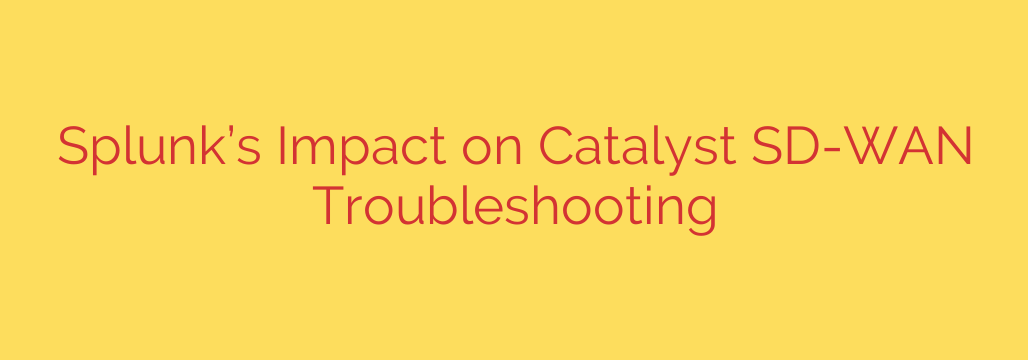
Mastering Catalyst SD-WAN Troubleshooting with Splunk
Modern networks are powered by Software-Defined Wide Area Networking (SD-WAN), and Cisco’s Catalyst SD-WAN is a leader in this space, offering incredible flexibility and control. However, this sophistication can also introduce complexity, especially when things go wrong. Troubleshooting a distributed system with multiple controllers (vManage, vSmart, vBond) and hundreds or thousands of edge routers (cEdges) can feel like searching for a needle in a haystack.
The traditional approach of SSH-ing into individual devices to check logs is inefficient and rarely shows the full picture. This is where integrating a powerful data platform like Splunk can transform your network operations from reactive to proactive. By centralizing and correlating data from every corner of your SD-WAN fabric, you can gain unprecedented visibility and slash your mean time to resolution (MTTR).
The Core Challenge: Disconnected Data
In a Catalyst SD-WAN environment, a single issue can generate logs across multiple components. An application performance problem, for instance, might involve:
- cEdge routers: Logs related to data plane tunnels (IPsec/GRE), BFD (Bidirectional Forwarding Detection) session flaps, and local policy decisions.
- vSmart controllers: Logs detailing control connection status, OMP (Overlay Management Protocol) route advertisements, and policy dissemination.
- vManage: Centralized event logs, device alarms, and configuration change histories.
Without a unified view, correlating these events is a manual, time-consuming process. Network engineers are forced to piece together a timeline from disparate sources, a task that is both difficult and prone to error.
How Splunk Revolutionizes SD-WAN Visibility
Splunk acts as a central nervous system for your network’s machine data. By ingesting logs, events, and telemetry from your entire Catalyst SD-WAN fabric, it provides a single pane of glass for monitoring, analysis, and troubleshooting.
Here are the key ways Splunk enhances SD-WAN operations:
Centralized Log Aggregation: The most fundamental benefit is pulling all your logs—from vManage, vSmarts, and every single cEdge—into one searchable repository. This immediately eliminates the need to manually access individual devices, saving valuable time during an outage.
Powerful Search and Correlation: Splunk’s Search Processing Language (SPL) is the key to unlocking insights. You can run queries that correlate events across the entire fabric. For example, you can instantly see if a BFD session flap on a specific router coincided with an OMP route withdrawal from the vSmart controller, pointing you directly to the root cause.
Proactive Monitoring with Dashboards: Move beyond reactive troubleshooting. With Splunk, you can build custom dashboards that visualize the real-time health of your SD-WAN. Track key performance indicators (KPIs) like tunnel latency, jitter, packet loss, and application performance scores. Visualizing these trends helps you spot degradation before it becomes a service-impacting outage.
Intelligent Alerting: Configure alerts to automatically notify you of critical events. For example, you can create an alert for when a control connection (DTLS/TLS) flaps, a high-priority circuit exceeds its latency threshold, or a specific security policy is violated. This automation reduces Mean Time to Detect (MTTD) and allows your team to act faster.
Practical Use Cases for Solving Real-World Problems
Let’s look at how this integration solves common SD-WAN headaches.
1. Diagnosing Intermittent Control Connection Failures
A cEdge router that frequently disconnects from the vSmart controller can be difficult to diagnose.
- Without Splunk: You would SSH into the cEdge, check logs, then SSH into the vSmart and try to match timestamps—a frustrating process.
- With Splunk: You can run a single search query that pulls all logs related to the cEdge’s system IP and the vSmart’s IP address within a specific time window. You can quickly identify DTLS handshake errors, certificate validation issues, or network reachability problems that caused the drop.
2. Pinpointing Application Performance Degradation
A user complains that a critical SaaS application is slow. Is it the LAN, the SD-WAN, or the application provider?
- Actionable Tip: Configure your cEdge routers to export cflowd (NetFlow) data to a Splunk forwarder.
- With Splunk: You can filter traffic by the specific application, overlay tunnel, and user. Create a dashboard to visualize latency, jitter, and packet loss for that application’s traffic across different WAN circuits. This allows you to definitively determine if the SD-WAN is dropping packets or if a specific ISP circuit is underperforming, enabling you to reroute traffic or escalate to the correct provider.
3. Enhancing Security and Compliance Monitoring
Your cEdge routers are also a critical part of your security posture, acting as distributed firewalls.
- Actionable Tip: Ensure your cEdge routers are logging all firewall policy actions (permit/deny) to syslog and forwarding them to Splunk.
- With Splunk: You can create dashboards to monitor for security threats. Visualize denied traffic, look for unusual connection patterns, and set alerts for repeated connection attempts from a suspicious IP address. This turns your SD-WAN fabric into a distributed sensor grid, significantly improving your security visibility at the network edge.
Getting Started: A High-Level Integration Path
- Configure Data Forwarding: In vManage, configure your device templates to send syslog data from all SD-WAN components (controllers and edges) to your Splunk collector or heavy forwarder.
- Use the Splunk App: The Splunkbase repository contains a “Splunk App for Cisco SD-WAN” which provides pre-built dashboards, data models, and searches. This is the fastest way to get value from your data.
- Customize and Build: While the app is a great starting point, the true power comes from customization. Build dashboards that reflect your organization’s unique KPIs, critical applications, and network topology.
By integrating Splunk with Cisco Catalyst SD-WAN, you move beyond basic monitoring. You create a data-driven, intelligent operation that can identify issues faster, monitor performance proactively, and ultimately deliver a more reliable and resilient network.
Source: https://feedpress.me/link/23532/17099391/use-splunk-to-troubleshoot-catalyst-sdwan-distributed-compute-systems








